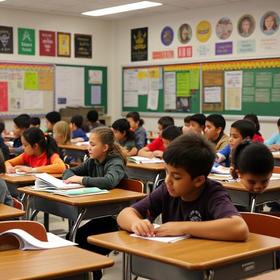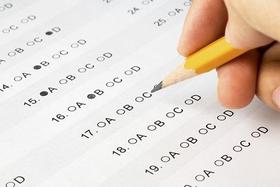Top Rankings
Warwick School District ranks among the top 20% of public school district in Pennsylvania for:
Category
Attribute
Reading/Language Arts Proficiency
Highest reading/language arts proficiency (Top 20%)
Graduation Rate
Highest graduation rate (Top 10%)
Community Size
Largest student body (number of students) (Top 1%)
For the 2025-26 school year, there are 2 public high schools serving 1,834 students in Warwick School District. This district's average high testing ranking is 8/10, which is in the top 30% of public high schools in Pennsylvania.
Public High Schools in Warwick School District have an average math proficiency score of 37% (versus the Pennsylvania public high school average of 30%), and reading proficiency score of 69% (versus the 58% statewide average).
Public High School in Warwick School District have a Graduation Rate of 95%, which is more than the Pennsylvania average of 88%.
The school with highest graduation rate is Warwick Sr. High School, with 95% graduation rate. Read more about public school graduation rate statistics in Pennsylvania or national school graduation rate statistics.
Minority enrollment is 18% of the student body (majority Hispanic), which is less than the Pennsylvania public high school average of 39% (majority Black and Hispanic).
Overview
This School District
This State (PA)
# Schools
6 Schools
790 Schools
# Students
3,768 Students
641,839 Students
# Teachers
270 Teachers
46,794 Teachers
Student-Teacher Ratio
14:1
14:1
Student By Grade
District Rank
Warwick School District, which is ranked within the top 30% of all 678 school districts in Pennsylvania (based off of combined math and reading proficiency testing data) for the 2022-2023 school year.
The school district's graduation rate of 95% has decreased from 97% over five school years.
Overall District Rank
#143 out of 685 school districts
(Top 30%)
(Top 30%)
Math Test Scores (% Proficient)
46%
38%
Reading/Language Arts Test Scores (% Proficient)
66%
55%
Science Test Scores (% Proficient)
68%
57%
Graduation Rate
95%
87%
Students by Ethnicity:
Diversity Score
0.33
0.59
% American Indian
n/a
n/a
% Asian
2%
4%
% Hispanic
10%
15%
% Black
3%
15%
% White
81%
61%
% Hawaiian
n/a
n/a
% Two or more races
4%
5%
All Ethnic Groups
District Revenue and Spending
The revenue/student of $21,494 in this school district is less than the state median of $23,696. The school district revenue/student has stayed relatively flat over four school years.
The school district's spending/student of $18,066 is less than the state median of $23,119. The school district spending/student has stayed relatively flat over four school years.
Total Revenue
$81 MM
$39,541 MM
Spending
$68 MM
$38,578 MM
Revenue / Student
$21,494
$23,696
Spending / Student
$18,066
$23,119
Best Warwick School District Public High Schools (2025-26)
School
(Math and Reading Proficiency)
(Math and Reading Proficiency)
Location
Quick Facts
Rank: #11.
Warwick Sr. High School
(Math: 35-39% | Reading: 75%)
Rank:
Rank:
7/
Top 50%10
301 W Orange St
Lititz, PA 17543
(717) 626-3706
Lititz, PA 17543
(717) 626-3706
Gr: 9-12 | 1,243 student Student-teacher ratio: 14:1 Minority enrollment: 18%
Rank: #22.
Warwick Middle School
(Math: 37% | Reading: 66%)
Rank:
Rank:
6/
Top 50%10
401 Maple St
Lititz, PA 17543
(717) 626-3705
Lititz, PA 17543
(717) 626-3705
Gr: 7-9 | 591 students Student-teacher ratio: 12:1 Minority enrollment: 17%
Recent Articles

How Public Schools Support Students on Free / Reduced-Lunch Programs
Explore how U.S. public schools support students eligible for free or reduced-price lunch through nutrition, academic, and wraparound services in 2025.

Hidden Costs of Public Schools: Fees, Supplies & Extras
Explore the hidden costs in public schools鈥攆ees, supplies, extracurriculars鈥攁nd how parents can plan for them in 2025.

Public School Funding 2025: What Families Should Know
Essential insights on public school funding in 2025鈥攈ow it works, what鈥檚 changing, and what families should know to stay ahead.





